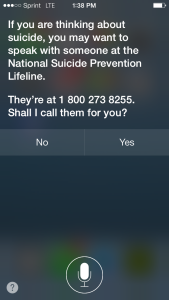I&R and Crisis Call Centers
now browsing by category
Why Service Providers Must Start Preparing for I&R Linked Data RIGHT NOW

 I&R needs to change how it handles data, and fortunately AIRS is providing leadership and action on this by developing a linked data strategy. As AIRS continues its progress with the linked data strategy, the rest of I&R should begin preparing for the advent of I&R linked data.
I&R needs to change how it handles data, and fortunately AIRS is providing leadership and action on this by developing a linked data strategy. As AIRS continues its progress with the linked data strategy, the rest of I&R should begin preparing for the advent of I&R linked data.
What is an API? What is Linked Data? How did this come about?
If you’re up-to-date on the linked data strategy, skip this section. In 2014, AIRS recognized the need to develop an application-programming interface (API) for I&R data. This would allow the I&R data stores more accessible to each other and to the outside world, and enable key technologies such as mobile app development.
Without getting too technical, AIRS decided eventually on a “linked data” strategy. This strategy would give each data item a series of uniform characteristics that make them index-able. It’s similar to the way search engines like Google work. For example, when you search for “How to make eggs benedict,” Google displays a list of recipes. This is possible because the website-makers told Google that their content is indeed a “recipe,” and that the recipe is for “eggs benedict,” and so on. This may be an over-simplified analogy but you get the basic idea.
I&R’s Next Huge API Hurdle
The development of the linked data strategy is a tremendously technical task that is in capable hands. But once the AIRS team has built the “airplane,” how are we going to fly it? Where will it take off and how is it going to land? These are questions that I&R leaders should be exploring immediately.
For instance, one major issue will be data management. Data is a shared digital resource that needs to be maintained, like water in a swimming pool. If it’s left to stagnate, it’ll get funky. It’s too costly a job for just one organization to maintain and having everyone chip in a little effort is laborious to implement.
Another issue is getting all the service providers on the same page in regards to data management. Linked data is a great strategy but it requires some unification and industry-wide change. For example, everyone has to agree to standards and adapt their businesses to include these guidelines. The diverse interests of I&R providers could make this difficult.
These are just some of the tasks I&R must begin to address, and no doubt more obstacles will surface. AIRS is taking a huge step forward on behalf of I&R, but implementing the linked data strategy will be a major undertaking even after the technology is developed. To prepare, I&R leaders should begin receiving direction on how to get ready for the advent linked data.
Crisis Intervention Technology Spotlight: Telemental Health and NAASP

Crisis intervention technology continues to leverage Web and mobile space, leading to improvements in service efficiency and reach. Increasingly, organizations such as the National Action Alliance for Suicide Prevention (NAASP) are reviewing tele-medical strategies for suicide prevention.
About NAASP
The National Action Alliance for Suicide Prevention (NAASP) has a lofty vision: a nation free from the tragic experience of suicide. The organization hopes to save 20,000 lives between 2010 when the nation was founded and 2015.
To complete actualize its vision, NAASP created Zero Suicide Advisory Group. Zero Suicide is NAASP’s strategy of expanding suicide prevention in healthcare systems. Its primary concern is patient safety.
The strategy comprises six components:
- Creating a culture of zero suicide by confronting the culture of pessimism and hopelessness in healthcare organizations regarding making any real progress in suicidal cases.
- Ensuring every person has a pathway to care by providing screening tools and promoting screening options.
- Developing a competent workforce by training healthcare providers to handle situations involve suicide.
- Identifying and assessing risk level during primary care.
- Using effective, evidence-based care by employing data-backed studies that indicate that suicidal ideation should be treated directly and not as a symptom to a problem.
- Continuing contact after care by providing critical follow-up interventions to ensure the ongoing safety of patients.
Virtual/Remote Suicide Prevention
One way that NAASP will carry out its suicide-prevention goals is technology-based care. This involves administering crisis intervention services remotely.
According to NAASP, virtual or remote care can keep give suicidal persons constant access to help throughout all hours of the day and night. This involves multiple crisis intervention strategies, including existing strategies of phone lines, emerging strategies including text and chat, and developing strategies including telecounseling, online video counseling, and self-assessment.
According to a 2013 report published by the American Telemedicine Association (ATA), telemental health is one of the most active telemedicine applications rendered in the United States. The service delivery strategy is efficient and allows clinicians to broaden their reach to patients. Telemental health can even be delivered over mobile devices – an extremely fast growing method of communication.
It may be that, in the future, telemental health and crisis intervention services will work more closely together. Where in the past, crisis intervention services could only be accessed from a phone, now a person can only speak, text, and chat with a crisis counselor via mobile phone, but also teleconference with a professional clinician as well. Further, all of this can take place in a short amount of time, and for less cost to the client than ever before.
New York Times Crisis Text Line Article Demonstrates Public’s Interest in the Service

The February 4, 2014 The New York Times Crisis Text Line article describes the text-based crisis counseling service and how it better serves youth in an increasingly non-verbal world.
The article, titled “In Texting Era, Crisis Hotlines Put Help at Youths’ Fingertips,” by Leslie Kaufman, vaguely describes an real chat taken by Crisis Text Line, a subsidiary of DoSomething.org. The situation is one in which a young female caller is distressed from gender identification issues, and tells the specialists that her family has disowned her because of her expressed desire to be a male.
The article breaks out the numerous benefits to texting, including: the ability for counselors to take multiple text sessions, seamless reopening of a text session after it has been interrupted, and the ability to text in public without privacy concerns. It also talks about how text is better at reaching youths, many of whom do not require lengthy rapport-building before disclosing suicidal or other severe tendencies. This is usually the case with phone crisis counseling, according to the article.
Ron White, chief program officer for Samaritans Inc., commented on this matter in the article, stating: “On the phone there is sometime building a rapport,” he said, “but young people on text tend to get right to the point.”
To demonstrate how text clients are more open with specialists, the article excerpts text that is presumably from a real text session:
“He won’t stop raping me. It is my dad. He told me not to tell anyone. Are U there?”
Nancy Lublin, the founder of the Crisis Text Line, was the main interview subject for the article. Although Lublin did grant The Times access to text transcripts, citing confidentiality concerns, she was able to show them text data and transcripts that were stripped of identifying information.
Interestingly, the article refers to crisis texting as a “nascent” technology. Now that This reflects the publics view of crisis text as an innovative and burgeoning new service that people come to expect in the digital age. Now that crisis intervention is reaching large new populations, the industry is seeing a re-introduction to the national community. As new crisis intervention technologies continue to mature, the industry may see more publicity going forward.
Aaron Blackledge was one of the pioneers of Crisis Chat, and helped to establish the service in Baton Rouge, Louisiana – the second city in the United States to host the service. Aaron went on to help help numerous cities throughout the nation, as well. Also, For questions about text or chat, or to learn more, contact Aaron today.
Crisis Intervention Technology Round-Up

Technology is changing the game in crisis intervention. Innovative organizations are continually finding new ways to reach larger audience.
Here’s how some prominent crisis intervention organizations are using crisis intervention technology to great effectiveness:
Emotion Technology Looks to the Next Generation
Emotion Technology CEO Christopher Gandin Le recently publish an article in the Huffington Post stating that the future of suicide prevention rests on the new ideas of young people and new technology.
“I’ve reached the limit to what I can imagine as one person,” said Le. “ It’s time for people who are far smarter than me and far less experienced in doing this work to innovate.”
Siri Helps Prevent Suicide
Telling your iPhone assistant that you are thinking about hurting yourself now leads to automated intervention on behalf of Siri.
The voice-activated software responds to several similar commands, such as “I want to jump off a bridge,” and refers the National Suicide Prevention hotline number to the user. Could a direct connection to a Crisis Chat channel be the next feature in store?

NSPL Steps Up its Content Creation
Many crisis interventions organizations are stepping up their content creation game to reach audiences where they are – the Web.
Lifeline’s stylish blog titled You Matter looks fantastic and is extremely readable. There are several dozen posts for audiences who are in crisis or may be worried about someone else in crisis. Self-care tips, positive message, and tutorials are common themes for the blog.
Veteran’s Crisis Hotline Goes Mainstream
The highly successful Veteran’s Crisis Line (hotline, online chat & text) has garnered considerable attention from major media companies.
HBO’s documentary Crisis Hotline: Veterans Press 1 spotlights the traumas endured by America’s veterans as seen through the eyes of the crisis counselors who take the calls and chats.
Additionally, NPR published an article in September 2013 about the veteran’s service which describes the stories soldiers share with the hotline. The article features four hotline employees who share their experiences with StoryCorps, — an American non-profit organization whose mission is to tell the stories of Americans from all backgrounds and belief.
Have an idea for a crisis intervention technology project? We’d love to hear about it! Contact us today.
Five Essential Volunteer Committee Development Strategies

Being head of a volunteer committee is your time to shine. However, you’ll only succeed if you can identify and properly execute the proper committee development strategies.
Use these strategies to develop your committee and set them up for success:
Connect to leadership. Volunteer committee members must feel like their work is being recognized and appreciated, and this may involve participation and the highest levels of an organization.
Try to connect your volunteer committee with an executive or some higher board, if one exists. This way, your professional volunteers are making connections, staying motivating, and getting a great overall feeling about the importance of their work.
Have a strategy for overcoming knowledge gaps. Advisory committees often strive to have a wide breadth of knowledge. While this is a great idea, it may lead to a shortfall of knowledge if the committee focuses deeply on something.
Consider instigating advisory positions for your committee. This could be guest members who participate but do not have the full commitment of members.
Plan for growth and recruitment. If you are leading a permanent committee, always be thinking about sustainability. This is something you probably can’t do alone.
Set clear expectations with committee members that they will be expected to refer possible members or advisors. This doesn’t mean they will have to jockey professional relationships, but they should nonetheless feel compelled to keep their eyes and ears open for possible recruits at all hours of the work day.
Develop strong relationships. Work can bring people closer together, and this enhances the quality and effectiveness of the work. Unfortunately, technology can take the human element out of this, and telecommunication (a popular method for volunteer boards) can hinder relationship development.
The tech committee leader should be mindful of the ways relationships are developing as the committee progresses. The committee leader should shake things up the event that people just aren’t warming up to each other, and assign partnerships are special tasks.
Build awareness of committee value. Do people appreciate what your volunteer committee does? This is critical for morale, especially for new committee.
Tap into your organization’s regular publications or media channels to plug the good work of your committee.
Aaron G. Blackledge has served on numerous local and national boards and committees. To schedule a free 30-minute consultation, contact Aaron today.
9 Great Reasons to go with Unified Telephony for I&R Services

When considering ways to improve I&R services, it pays to know your options. Hands-down, unified telephony for I&R is the best way to move I&R providers the next level of performance.
Unified telephony provides the following benefits to I&R service providers:
Efficiency benefits:
Benefit #1: Load-balanced calls between the centers to allow for flexible staffing and reduce waste from overstaffing. By leaning on each other, the centers can do more with less. Not to mentioned, unified networks are incredibly convenient and take away many stressors that can befall call center managers.
Benefit #2: Improved ability to forecast calls and predict scheduling requirements. Having a greater overflow capacity and access to more data makes it easier to be prepared,
Service quality benefits:
Benefit #3: Optimized georouting processes to rout callers to the appropriate centers. When call centers unite, routing tables are typically reviewed and updated, which improves service quality and provider efficiency.
Benefit #4: Updated analytical practices to get more value from data. When was the last time you tuned up your data practices?
Benefit #5: Improvement in key metrics such as answer rate and abandonment rate. Numbers don’t lie. Overwhelmingly, call center networks show improved performance.
Benefit #6: Increased ability of the network to absorb the effects of power outages through call routing. Whatever you call it – routing, triaging, overflow – you’ll be able to do it better in a network than on your own.
Unification benefits:
Benefit #7: Establishment of a universally agreed-upon routing tables for calls in split areas and out-of-state calls. Unification necessitates that all centers sit down and agree upon a routing procedure. The process only takes a few hours and is great for boosting performatnce.
Benefit #8: Balanced call-routing measures with the service needs of 2-1-1 and other programs hosted locally by the call centers. An effective unification strategy means that all centers have the flexibility to pursue their own contracts and provide their own unique services and still be able to rely on the center.
Revenue benefit:
Benefit #9: More contracts and grants. Better performance and increased capacity is leading to more contracts. In fact, many I&R service providers are reporting that clients insist upon a unified network before they’ll sign anything.
GeauxPoint is a Baton Rouge, LA-based consulting and strategy firm that specializes in I&R and crisis call center consulting, Salesforce.com consulting, and business and IT consulting. Contact us for a free 30-minute consultation for advice on how to improve the performance of your organization.
